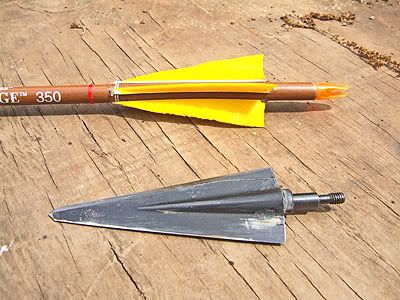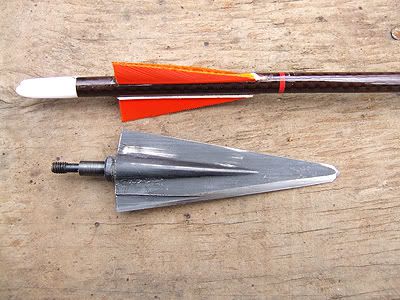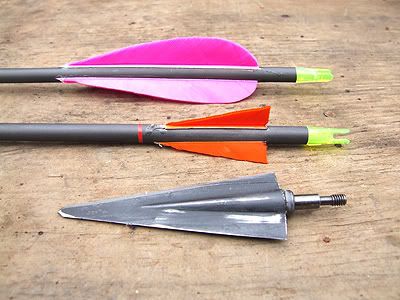Forum Replies Created
-
AuthorPosts
-
in reply to: Wyoming Pronghorn Spot and Stalk Success #35145
That speaks well of your stalking skills. Making a successful stalk on a pronghorn is a rare trophy, in and of its self; one few bowhunters will ever have!
Ed
in reply to: A long look at fletching and EFOC #35008That’s straight forward and ‘spot on’ Steve.
Ed
in reply to: A long look at fletching and EFOC #34974David, your post bring up a very important point. There’s enough data now to verify that going up in FOC enough (into EFOC and Ultra-EFOC) will let a significantly lighter arrow equal the penetration of a much heavier arrow having a normal or high FOC; but that does NOT mean that it will equal the penetration of a heavier arrow of “like dimensions” that has a like-amount of EFOC/Ultra-EFOC.
Arrow mass still matters, but EFOC/Ultra-EFOC will allow a lighter arrow to equal or exceed the penetration of a much heavier arrow having ‘commonly used’ FOC.
Ed
in reply to: woodsman elite broadheads #34967Patrick, if you ever have one of those fail in any way, be sure to post about it; and you can post anything good too. It’s failures that we learn from. I tried my best to damage on of ABS Ashby’s on heavy bone, but couldn’t do it. Nonetheless, it will take years for them to develop a track record like the the 190 Grizzly has, but, after testing, I have enough confidence to use them for my ‘serious hunting’, side by side with the Grizzly.
Ed
in reply to: Performance Report: A successful failure #34961Consider that this gemsbok (Oryx) is smaller in body size than most any elk; and its bones are not as heavily constructed of those of even a decent young bull elk! That’s worth more than a bit of serious pondering.
Ed
in reply to: A long look at fletching and EFOC #34952Mark,
You’ve pretty well got the idea, but a couple need clarification. Feather fletching doesn’t require any offset to induce rotation. The natural curve of the feather creales a pressure differnetial for the air flow on each side of the feather. The A&A fletch is applied as a straight-fletch. There’s no functional reason why it can’t be offset, or even helical. However, the straight fletch is a bit more silent in flight; which I view as one of the greatest advantages.
As long as the fletching’s pressure is sufficient to stabalize the individual arrow there is no accuracy difference attributable to a difference in fletching size or shape.
The only broadhead factor to consider (other than alignment) is the wind shear factor. The greatest wind shear will be with wide, non-vented single blade heads, but velocity also has an effect. The faster your arrow, the greater the wind shear. As we found with Wesley’s compound, a high MA single-blade, single-bevel BH (the 190 Grizzly) on a well tuned EFOC arrow fired with a release can be stabalized with three, straight-fletched 2″ A&A fletches. With my rather poor quality finger release I need four 2.5″ fletches to consistently and relaibly stabalize the same broadhead at a near-equal amount of arrow FOC (and that’s the minimum fletching that works on my occasional REALLY BAD releases). Just as with everything about your arrow setup, you want to try for the best, but be sure you’re prepared for the worst … in this case, enough fletching to stabalize the arrow on your ‘worst releases’.
Hope that helped,
Ed
in reply to: woodsman elite broadheads #34930I just received a WW Elite report this morning. It’s posted on the Arrow Lethality forum, with photos.
Ed
in reply to: A long look at fletching and EFOC #34855Patrick, as far as stability it’s the fletching surface area that matters. The A&A pattern has a straight, vertical cut at the fletching’s rear. We have experimented a fair amounht with the sound in flight (with approximately same surface area but different fletching shapes) and the absolute square (vertical cut) trailing edge is the most silent we’ve found.
Uning a wrap with turbulator is no problem from a functional standpoint, it works well. Just add turbulator on the wrap. Be sure the wrap is fairly long, so its leading edge is not anywhere near the turbulator’s position. I don’t use wraps on any of the EFOC/Ultra-EFOC arrows. They just add unnecessary weight at the shaft’s rear, reducing FOC. It is also helpful to keep the fletching as far back on the shaft as you possible can (while leaving clearance for your fingers). This increases the length of the arrow’s rear stearing arm – the distance from the arrow’s center of pressure in flight to the point where the fletching’s stabalizing pressure is applied upon the shaft.
Ed
in reply to: A long look at fletching and EFOC #34640Hiram, I have not done any testing with vanes, but other have, and the results were similar. There’s an FOC article in the Nov. Bowhunting World by Richard Combs that talks about being able to use smaller vanes as FOC goes up. However, as he correctly points our, vanes of corresponding size weigh more than feather fletching, reducing arrow FOC.
Patrick, yes, you can cut strips from an arrow wrap to use as a turbulator. However, a roll of pinstripe tape from a hoby shop is inexpensive, and does hundreds of arrows. The pinstripe tape is the narrow one, about 1mm wide.
I have not tried using the lead edge of an arrow wrap as a turbulator, but some others have. They report that it works, but I’m told by the aeronautical engineers that it wouldn’t work as well as the tape, because the tape is a true ‘bump’ – up on the lead edge and down on the back edge – whereas the fletching wrap would be only a ‘up-bump’ for the air flow.
Note that the distance the turbulator is placed in front of the fletching is important. Optimum appears to be 1/4″. That’s based on O.L. Adcock’s extensive turbulator testing with flight arrows. He also found that there must be only one, single turbulator. Multiple turbulators didn’t work well, regardless of their number or placement(s).
Hope that helps.
Ed
in reply to: Internal Footings #34606All the newer Updates are posted right here. Just go to the ‘Ashby Library” at the page top.
Ed
in reply to: A long look at fletching and EFOC #34076Dave, the turbulator is the tiny raised red band you see in the photos, located 1/4″ forward of the fletching. It’s a piece of pinstriping tape – available at most hobby shops. It acts to disrupt the ait flow, increasing pressure on the fletching. It works too. I can go down to a fletching size that won’t stabalize the broadhead, add the turbulator and presto; total stability again.
We’re getting both types of testing. When it comes to any potential accuracy effects I tend to turn to Wesley. There’s just no way I can shoot accurately enough to tell exactly what’s happening. Wesley is as close to a shooting machine as anyone I’ve ever met.
With my very poor finger release I have to use a 2.5″ four fletch. Those works on all my EFOC setups, from sub 650 grains to 900+ grains. I’ve tested and hunted with them on the EFOC setups for almost 2 years, and have had nothing but fantastic results. I’m hoping that I’ll be able to go a bit smaller on the fletching on an Ultra-EFOC setup.
Ed
in reply to: Internal Footings #33885Kingwouldbe wrote: … it also imparts “IMHO” ten times the flight response in the animal.
That’s spot on, and very, very few folks seem to realize it!
You’re right about Fred too. Everyone thinks of him and then the “4-blade Razorhead”. I personally heard Fred say that the bleeder blade was for one thing; to open the skin to reduce arrow drag, increasing penetration. The hard, blue steel in his bleeder blade was specifically chosen to shatter in bone impact and, as Fred said “let the broadhead penetrate like any other good single blade”. The famous “shooting them once with a Razorhead is like shooting them twice with other broadheads” was purely a sales gimick thought up by the advertizing agency.
Ed
in reply to: Internal Footings #33766I Love it, Dave! But … EVERYONE KNOWS that narrow single blade broadheads don’t make big holes in the hide, don’t do much damage to the tissues, and they NEVER leave a blood trail! 🙄
Ed
in reply to: A long look at fletching and EFOC #33724Steve,
This is an area of EFOC and Ultra-EFOC arrow design that needs to get more attention from hunters. There are some big benefits, and I’ve migrated to using the tiny A&A fletch on my serious hunting arrows. Of course there’s the decreased drag in flight, with better trajectory and more retained arrow force downrange, along with less deflection in crosswind conditions, but that’s not what I find to be the biggest advantages. The biggest advantages are: (1) a clearly present reduction in noise in flight; (2) the tiny fletching is far less visible to game; and (3) there is a major wet-weather benefit. NOTE: Your shaft setup needs to be well tunded BEFORE you start working on minimum fletching required to stabalize your broadhead. Even at EFOC, small fletching won’t work well when the shaft’s dtnamic spine is not correct.
Wesley did some test shooting for me (I can’t shoot well enough at forty yards to hit those tiny target dots!). From his compound, we took 190 gr. Grizzly BH’s on a 26%-27% FOC setup with the A&A fletching. Shot them dry then soaked the fletching in a bucket of water for a full 30 minutes and, without even shaking the water off the fletching, shot again. At 40 yards there was absolutely no change in point of impact. I think a lot has to do with the stiffness of the low-cut fletching (which you can only get away with using if your arrow has very high FOC). Even after 30 minutes of soaking there’s no visible matting down of the fletching. Those shots were with untreated feathers – no form of add-on waterproffing whatsoever.
For any unfamiliar, here are a few photos of the A&A fletch. Their appearance does take a bit of getting use to. The red ring is the turbulator.
#1: With EFOC 0.5″ tall, 2.5″ four-fletch A&A works for my very poor quality finger release. Once I get a good Ultra-EFOC setup I may be able to go smaller.

#2: 0.5″ tall, 2″ three-flect A&A worked with mechanical release from Wesley’s compound. This is the fletching we water-soaked and tested.

#3: Compare the fletching surface area between the 2″ A&A and the 3″ parabolic cut fletching. When thoroughly water soaked the A&A still stabalized the broadhead’s flight; the 3″ parabolic didn’t.

#4: Looks starnge; works great!

Ed
in reply to: Internal Footings #33686David,
You have no idea how much I appreciate the feedback I get from your field results. There’s a good number of folks using penetration enhanced arrow setups now, but few really LOOK to see the terminal performance, and fewer yet get the good ‘damage photos’ you do.
I started out the 2008 testing to look at FOC’s effect (or lack there of) on the Heavy Bone Threshold. but it morphed into Ultra-EFOC. I think that’s exactly where we need to be headed. If I can recover from all this medical stuff and get back to doing things more important (LOL) I want to get to at least 35% FOC for some testing.
I totally concur. That scapular ridge hit is the toughest one to deal with. I’t not so much the amount of bone thickness as it is the multiple angles of bone impact on a single impact. Penetration of the BH can get ‘redirected’, deflected on a secondary course, by impact with the scapular flat while it’s still trying to penetrate the first bone impact (the ridge). That tends to bind the broadhead. When testing with some softer 3:1 double-bevel single blades (the early model Tusker Concord – not the currently made version) I got huge BH bends occurring at a point between ridge-impact and scapular flat impact. Had them with some other, lower MA single blade BH’s too. I’m really looking forward to what you find on those shots when you start the pig testing!
Ed
-
AuthorPosts

